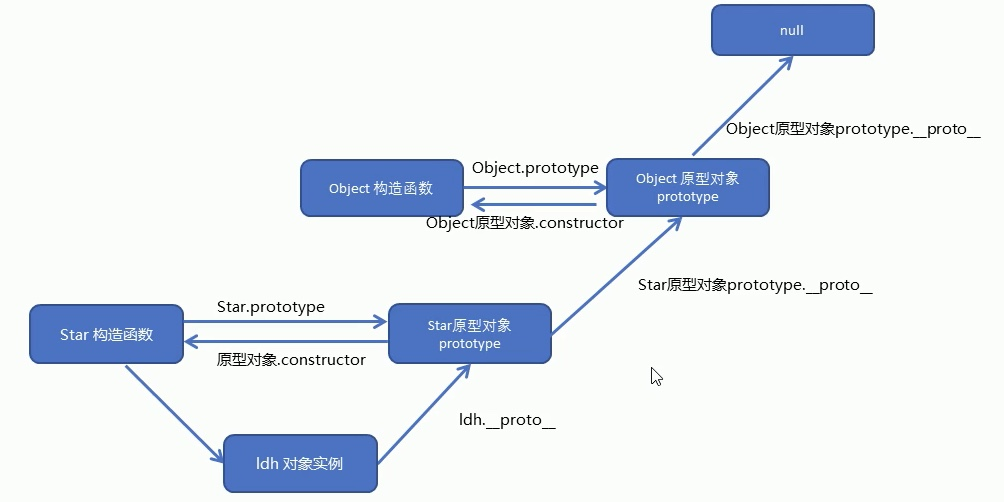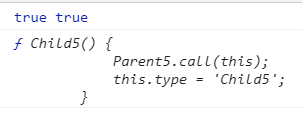创建对象的四种方式:
1.字面量方式
2.new Object()
3.构造函数创建
4.Object.create()
1 // 1.字面量创建
2 var o1 = {
3 name: 'o1'
4 }
5
6 // 2.通过new Object()创建
7 var o2 = new Object({
8 name: 'o2'
9 })
10
11 // 3.通过构造函数创建
12 var M = function() {
13 this.name = 'o3'
14 }
15 var o3 = new M();
16
17 // 4.通过Object.create()创建
18 var P = {
19 name: 'o4'
20 }
21 var o4 = Object.create(P);
构造函数,new在执行时会做四件事:
1.在内存中创建一个新的空对象
2.让this指向这个新对象
3.执行构造函数里的代码,给这个新对象添加属性和方法
4.返回这个新对象(所以构造函数里不需要return)
原型链:从一个实例对象网上找构造这个实例的相关联的对象,然后这个关联的对象再网上找,它又有创造它的上一级的原型对象,以此类推,一直到Object.prototype原型对象终止,那么这个链条就断了。也就是说,Object.prototype属性是整个原型链的顶端,到这儿就截止啦!(原型的作用就是共享方法)


instanceof原理
判断实例对象的_proto_属性与构造函数的prototype是不是同一个引用,如果不是,它会沿着对象的_proto_向上查找,直到顶端Object。也即判断对象实例与构造函数是否在一个原型链上。
继承的三种方法
1.借助构造函数实现继承
1 // 借助构造函数实现继承
2 function Parent1() {
3 this.name = 'Parent1';
4 }
5 Parent1.prototype.say = function() {};
6
7 function Child1() {
8 Parent1.call(this);
9 this.type = 'Child1';
10 }
11 console.log(new Parent1());
12 console.log(new Child1()); // 没有参数的时候加不加括号都可以

这里通过 Parent1.call(this)将父级的构造函数上的this指向子构造函数的实例上去。Parent1原型链上的东西没有被Child1继承,例如这里的say方法就没有被继承。
如果父类上的属性都在构造函数里面,那么完全可以实现继承。但如果父类的原型对象上还有其他方法的话,子类则继承不了。
2.借助原型链实现继承
1 // 借助构造函数实现继承
2 function Parent2() {
3 this.name = 'Parent2';
4 this.play = [1, 2, 3];
5 }
6
7 function Child2() {
8 this.type = 'Child2';
9 }
10 Child2.prototype = new Parent2();
11 var s1 = new Child2();
12 var s2 = new Child2();
13 s1.play.push(4);
14 console.log(new Child2());
15 console.log(s1.play, s2.play);
16 s1.name = 'js';
17 console.log(s1.name, s2.name);

3.组合方式实现继承(使用call继承和原型链继承)
1 // 组合方式实现继承
2 function Parent3() {
3 this.name = 'Parent3';
4 this.play = [1, 2, 3];
5 }
6
7 function Child3() {
8 Parent3.call(this);
9 this.type = 'Child3';
10 }
11 Child3.prototype = new Parent3();
12 var s3 = new Child3();
13 var s4 = new Child3();
14 s3.play.push(4);
15 console.log(new Child3());
16 console.log(s3.play, s4.play);

1 // 组合继承的优化1
2 function Parent4() {
3 this.name = 'Parent4';
4 this.play = [1, 2, 3];
5 }
6
7 function Child4() {
8 Parent4.call(this);
9 this.type = 'Child4';
10 }
11 Child4.prototype = Parent4.prototype;
12 var s5 = new Child4();
13 var s6 = new Child4();
14 Child4.prototype.say = function() {};
15 console.log(new Child4(), new Parent4);
16 console.log(s5.play, s6.play);
17 console.log(s5 instanceof Child4, s5 instanceof Parent4);
18 console.log(s5.constructor);

构造函数体内通过两个构造函数组合能拿到所有构造函数体内的属性和方法,现在是想继承父类的原型对象,所以直接赋值给子类父类的原型对象就行了。
1 // 组合继承的优化2
2 function Parent5() {
3 this.name = 'Parent5';
4 this.play = [1, 2, 3];
5 }
6
7 function Child5() {
8 Parent5.call(this);
9 this.type = 'Child5';
10 }
11 Child5.prototype = Object.create(Parent5.prototype);
12 Child5.prototype.constructor = Child5;
13 var s7 = new Child5();
14 console.log(s7 instanceof Child5, s7 instanceof Parent5);
15 console.log(s7.constructor);
